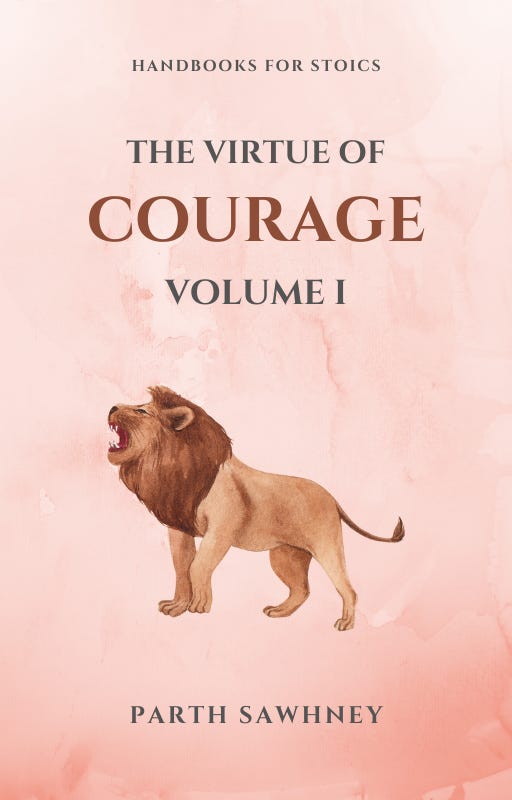the stoic who turned pale in a storm

In Aulus Gellius' The Attic Nights, there's a fascinating tale about a Stoic philosopher who found himself in a dire situation at sea. This anecdote, to be specific, describes the Stoic doctrine concerning involuntary emotional reactions or “proto-passions” (propatheiai), and thus, paints a vivid picture of human nature and the conflicting forces of reason and emotion that dwell within us.
The story unfolds with the Stoic philosopher embarking on a sea voyage. He was known for his unwavering commitment to Stoic principles, which emphasized reason, virtue, and emotional control.
However, as fate would have it, a fierce storm engulfed the ship. The vessel was tossed about violently, the waves crashing against its hull with terrifying force. Amidst this chaos, the philosopher's composure began to crumble. The sight of the turbulent sea and the imminent danger he faced triggered a visceral fear within him. His face turned pale, and his body trembled with anxiety.
When the skies were clear and the sea had calmed, another passenger approached the Stoic and asked him, “What does this mean, Sir philosopher, that when we were in danger you were afraid and turned pale, while I neither feared nor changed color?” The Stoic remained unperturbed and dismissed the man because of his disrespectful tone.
Later, another fellow passenger, who had also observed the philosopher's sudden change in demeanor, inquired about his distress. The Stoic teacher responded differently to this curious man and encouraged him to read the thoughts of the founders of Stoicism on such natural, inevitable fear. He then drew from his little bag the fifth book of the Discourses of the philosopher Epictetus, compiled by his student Arrian, which “undoubtedly agreed with the writings of Zeno and Chrysippus.”
In this work, Epictetus explained that the first stages of fear are unavoidable. No matter the person, the initial reaction to a falling building or a sinking ship is to panic and feel the clutches of fear. An inescapable grip that can threaten to take hold of rational thought and mental clarity.
While the philosopher, true to his Stoic teachings, had aspired to maintain emotional equanimity, the raw power of nature and the prospect of death had briefly overwhelmed his rational faculties.
However, Epictetus also pointed out that the wise man does not entertain these initial reactions. He does not approve of them, rather, he condemns and rejects them.
“And they say that there is this difference between the mind of a foolish man and that of a wise man, that the foolish man thinks that such ‘visions’ are in fact as dreadful and terrifying as they appear at the original impact of them on his mind, and by his assent he approves of such ideas as if they were rightly to be feared, and ‘confirms’ them …. But the wise man, after being affected for a short time and slightly in his colour and expression, ‘does not assent,’ but retains the steadfastness and strength of the opinion which he has always had about visions of this kind, namely that they are in no wise to be feared but excite terror by a false appearance and vain alarms”
– Epictetus, The Discourses
Seneca wrote:
“There are misfortunes which strike the sage – without incapacitating him, of course – such as physical pain, infirmity, the loss of friends or children, or the catastrophes of his country when it is devastated by war. I grant that he is sensitive to these things, for we do not impute to him the hardness of a rock or of iron. There is no virtue in putting up with that which one does not feel.” (On the Constancy of the Sage, 10.4)
By this, he communicates that it’s human to get affected by a sudden challenge or adversity. A person who does not feel fear cannot conquer it, and hence, does not display courage. Courage, in essence, is the act of overcoming those feelings that threaten to bring about cowardice. It is about doing what’s right even if an individual is afraid to do so.
Marcus Aurelius too wrote about such inevitable emotional response in his private journal:
“Make sure that the ruling and sovereign part of your soul remains unaffected by every movement, smooth or violent, in your flesh, and that it does not combine with them, but circumscribes itself, and restricts these experiences to the bodily parts. Whenever they communicate themselves to the mind by virtue of that other sympathy, as is bound to occur in a unified organism, you should not attempt to resist the sensation, which is a natural one, but you must not allow the ruling centre to add its own further judgement that the experience is good or bad.” (Meditations, 5.26)
This nuanced understanding of fear and courage has profound implications. It challenges the notion that Stoicism demands the suppression of all emotions, instead recognizing the legitimacy of natural responses while emphasizing the importance of conscious choice.
This reminds me of a profound teaching by author and researcher Brené Brown. “There is no courage without vulnerability,” Brown said, “Vulnerability is not weakness. It's the ability to show up and be seen. It's the ability to be brave when you cannot control the outcome.”
The Stoic philosopher's pale face and visible fear serve as a poignant reminder that even the most dedicated adherents of philosophy are not immune to the primal instinct of self-preservation. This realization does not invalidate Stoicism but rather adds a layer of nuance to our understanding of human nature. It suggests that while philosophy can provide valuable guidance and tools for navigating life's challenges, it cannot completely erase our innate emotional responses.
In the end, the timeless tale of the Stoic philosopher's fear during a storm offers a rich insight into the complexities of human nature and the limits of philosophical ideals. It challenges our assumptions about Stoicism and reminds us that even the most disciplined individuals can succumb to fear in moments of crisis. This story ultimately serves as a call for humility and compassion, urging us to recognize the inherent fallibility of human nature and to approach philosophical teachings with a nuanced understanding of their limitations.
I’m so happy and grateful to announce the release of my new eBook “The Virtue of Courage: Volume I”.
In this second installment of the "Handbooks for Stoics" series, I provide a profound exploration of the virtue of courage from the ancient Stoic philosophers. With wisdom and insights derived from the teachings of Seneca, Epictetus, Marcus Aurelius, and others, “The Virtue of Courage” illuminates timeless principles for overcoming fear, remaining resilient through hardship, and bravely confronting life's inevitable challenges.

Drawing on classical texts and modern case studies, I illustrate what it truly means to lead a "courage-fueled life" in the 21st century. Readers will gain a new perspective on fear, anxiety, pain, failure, loss, and crisis – viewing them not as obstacles but as opportunities to strengthen their resolute character.
Whether facing daunting circumstances or daily micro-challenges, this indispensable handbook reveals the path to confronting problems with steady calm, clear judgment, and determined self-control.
For those seeking to honestly grapple with life's unavoidable adversities while embodying the wisdom of the ancient Stoics, “The Virtue of Courage” provides an inspiring and eminently practical guide. Reclaim your agency, embrace the philosophy of taking the high road no matter what, and become the courageous person you are meant to be.
Get your copy today! Learn more here.


